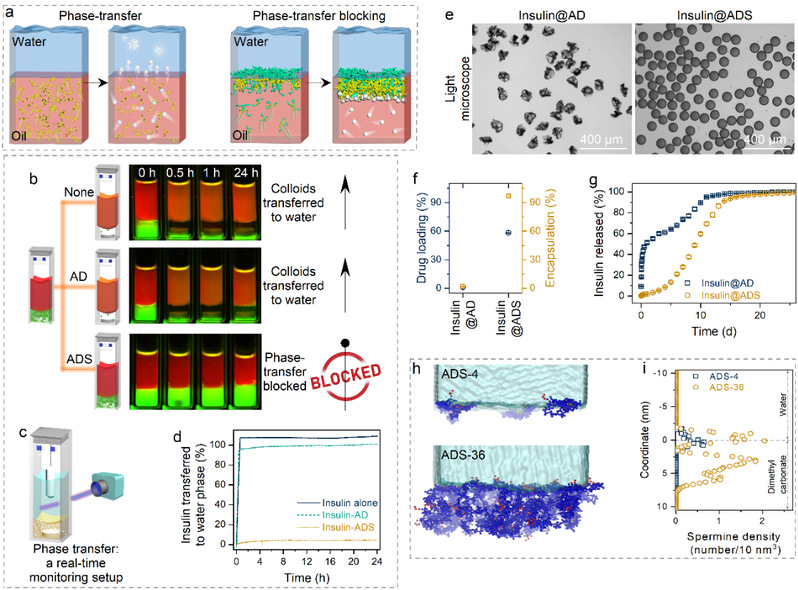Recently, the journal of Angew Chem published the latest research paper of Prof. Dongfei Liu's team on Colloidal Jamming by Interfacial Self-Assembled Polymers: A Robust Route for Ultrahigh Efficient Encapsulation. Qingqing Huo, a 2019 Ph.D. student at our university, is the first author of this paper, and prof. Dongfei Liu is the only corresponding author of this paper. China Pharmaceutical University is the sole corresponding unit of this paper. The main collaborators include Prof. Peng Quan from Shenyang Pharmaceutical University and Prof. Wen Li from Shanghai University.
Encapsulation, a powerful tool to embed cargoes into a variety of vehicles, is widely used in drug delivery, the microparticle is one of the typical representatives. Microparticles were used to regulate the pharmacokinetic properties in vivo such as the absorption and distribution of drugs, thereby improving the therapeutic efficacy and reducing its side effects. However, the efficient encapsulation usually depends on the chemical structure of the drug and the carrier material, and their intermolecular interactions. Due to the diversity of chemical structures of drugs to be encapsulated, it is difficult to meet the encapsulation needs of different drugs with the widely used carrier materials in clinical practice. A previous study by Prof. Dongfei Liu's team (NatComm 2022, 13: e1262) found that the encapsulation efficiency and drug loading degree could be significantly increased by forming drug colloidal particles within the emulsion droplets during the preparation process of microparticles. However, the high drug loading degree and encapsulation efficiency phenomenon are not in agreement with conventional encapsulation: an increase in drug loading degree is often accompanied by a decrease in encapsulation efficiency.
Recently, Prof. Dongfei Liu's team further found that amphiphilic polymer molecules with interfacial activity could form a robust interfacial film at the oil-water interface. The robust interfacial film could efficiently block the contact between colloidal particles with large spatial and the oil-water interface. The phase transfer of particles from the oil phase to the water phase was jammed, achieving high drug loading degree (up to 58.3 wt%) with efficient encapsulation (>95%). This study focused on the interaction between colloidal particles and the interfacial film formed with the self-assembled amphiphilic polymer molecules. This research systematically investigated the influence of polymer molecular structure on the structure and properties of the interfacial film by experiments and molecular dynamics simulations.
A real-time method was developed to directly measure the amount of particles transferred to the water phase (Patent No. CN202221539288.6), the influence of interfacial film structure on the phase transfer of colloids was clarified. The mechanism of interfacial film blocking the phase transfer of colloids has been elucidated from the molecular level by the effective interaction between molecular (drug and polymer molecules), mesoscopic (drug colloid particles and polymer interfacial film) and macroscopic (high-performance drug-loaded microparticles) levels. The prepared high drug-loaded microparticles prolonged the mean residence time in vivo of insulin from 3.1±0.2 h to 4.6±0.9 d. The mass of administrated amphiphilic polymers was 1889 times smaller than that of microparticles prepared with non-amphiphilic ones. The drug-loaded microparticles have outstanding advantages in reducing the frequency of drug administration and the inflammatory response around the injection site. This study effectively improves the core technology system of high-performance drug-loaded microparticles and guides the development of key equipment for the continuous flow production of microparticles.
The work was supported by the National Overseas High-Level Young Talents Program, the National Natural Science Foundation of China (51903251 and 81973266), the Natural Science Foundation of Jiangsu Province Basic Research Program (BK20190554), the Independent Research Project of the State Key Laboratory of Natural Drug Active Component and Pharmacokinetics (SKLNMZZ202221), and the Liaoning Provincial Education Department Research Fund (2020LJC04).
Article link:https://onlinelibrary.wiley.com/doi/10.1002/anie.202208738



